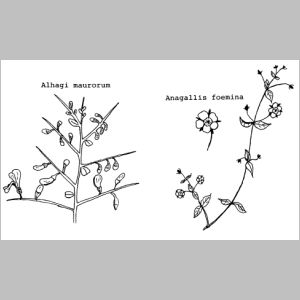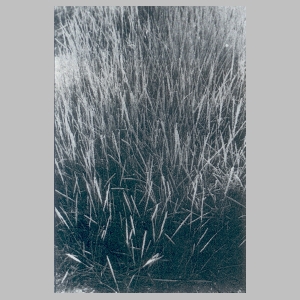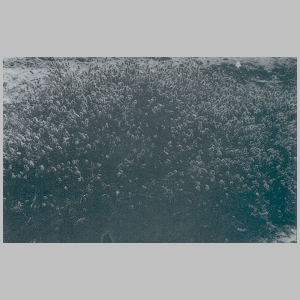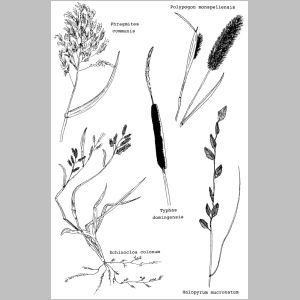Bulletin 17 - July 1982: The Natural Vegetation of Abu Dhabi Island: An Introduction
The Natural Vegetation of Abu Dhabi Island: An Introduction
by Rob WesternWith each passing year, Abu Dhabi town becomes increasingly green as parks, verges and roundabouts reflect the Government's desire to create a garden city as soon as possible. Five years ago the Airport Road was a barren wilderness along its entire length. Now the central reservation boasts shrubs and trees up to six metres tall. Most of this vegetation has been deliberately introduced, with species chosen for their adaptability to saline, sandy soils and the Gulf climate. One of the commoner exotic shade trees is the Indian Almond, Terminalia catappa, from tropical Asia. This tree has been introduced successfully into Africa and America too, and it is not exactly new in the Gulf, as some huge specimens in mountain oases in the eastern hills of the UAE testify.
The influx of exotic species is the direct result of a massive investment in terms of finance, technology and labour. The expense of importing soils and fertilizers plus the constant watering by a large labour force, must make the greening of Abu Dhabi one of the most costly experiments of its kind. All this, however, has been of benefit not only to us humans, but to the natural vegetation too, which has shown a ready ability to thrive and compete given improved growing conditions. The rains of February and March 1982 have shown just how many seeds have been lying dormant for years allover the country, with indigenous annuals taking advantage of any pocket of soil. Undoubtedly some of these species have been introduced in fertilizers, but nevertheless the majority are recorded elsewhere as native to the Arabian peninsula, and are to be regarded as such in the UAE.
The original soil cover of Abu Dhabi island is a heavily saline calcium carbonate sand, with one or two minor sandstone ridges. On the unprotected western and northern sides this consists of well over 7,000 ppm NaCl* and is unsuitable for any but the hardiest salt -tolerant species. However, the introduction of large amounts of fertilizers and constant watering has enabled several exotic species to take root, along with a few local annuals on the peripheries of the cultivated 'holes'. Generally, however, it is becoming increasingly difficult to find pockets of land where one can gain some impression of what the original biomass of the island must have comprised. One such area is the abandoned cemetery behind the Traffic Police HQ in Bateen, where the dominant plants are Heliotropium bacciferum and Cyperus conglomeratus, both very salt tolerant. Further evidence, in the absence of written documentation, can only be gleaned from old photographs. The present topography of the island, so much altered by urbunisation and reclamation, is misleading as a guide to past habitats. A visit to Sadiyat Island, however, offers the chance of viewing a similar landscape prior to large scale development since the 1960s. Sadiyat displays distinct vegetation zones, some of which are still reflected on Abu Dhabi Island, where for example the protected eastern shore is mainly a marsh and lagoon habitat. By contrast the centre of the island was originally windswept and subject to desert erosion processes, contributing to an unstable surface and a sparse biomass. This has now altered drastically because urbanisation has to some extent stabilised the surface although the original soil content has been changed in most areas. Many natural plant species have been able to establish convincing footholds which are disturbed only by man's passion for disruption of the natural environment.
One species well suited to local conditions is Dipterigium glaucum (Capparaceae Family) which can form large straggling colonies if left undisturbed. This perennial with thin pliant stems is adapted to withstand high winds and the abrasive effects of flying sand. The tiny leaves are opposite and simple, and in some plants falloff after flowering. The single axillary flowers are lemon-yellow and pollination is by insects, probably including ants. Unlike the majority of desert species, D. glaucum flowers intermittently during most of the year, depending on dewfall as well as Spring rains. There is a flourishing colony on the west-facing dune slopes of Sadiyat where individual plants up to 70 cms. tall have been recorded. A few plants can still be found in odd corners of Khalediya and further out towards Al Muqta. The species obviously prefers sandy saline habitats and is not found in cultivated areas.
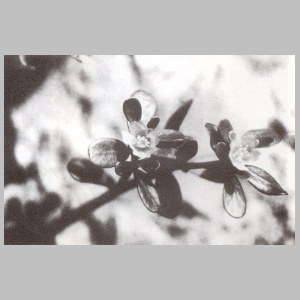
Common purslane - Portulaca oleracea
A very common plant that benefits greatly from artificial irrigation is Portulaca oleracea (Portulacaceae Family), the common purslane. For several years a colony existed at the Sewage Farm near the Defence Area, but more recently the species has colonised the entire town wherever there is a reasonably constant supply of water. The plant is nearly prostrate, with dark green fleshy leaves that sometimes turn purple. Flowers are small but numerous, bright yellow, and as spring advances into summer tend to open in the early mornings only. This plant is well-known in other parts of the Middle East as a salad and it can be found in the vegetable souk in Spring.
The Chenopodiaceae or Goosefoot Family is well-represented in various parts of the island. These mostly perennial herbs are halophytic, i.e. adapted to living in soils containing a high percentage of inorganic salts, and hence suited to the marsh around the Sewage Farm. All members of the family are deep-rooting and can become very well established. Sueda fruticosa and S. vermiculata (Sea blights) are the largest species, often forming dense bushes up to two metres tall. The two types are difficult to differentiate as they both have fleshy cylindrical leaves which turn a scaly black colour. One of the dominant Chenopodiaceae is Arthrocnemum glaucum, a glasswort which forms huge communities along lntertldal flats and is the first species to colonize newly-dredged areas. It grows to over a metre tall and individual branches have an almost cactus-like appearance as the leaves are reduced to green scales on a jointed stem. The minute yellow flowers emerge from these scales in great numbers usually in May and June but this year there was a prolific flowering season in March and April, perhaps due to the above average rainfall. The species forms important cover for insects and such birds as the Graceful warbler, which nest in the less approachable bushes. Helopeplis perfoliata with its multi-coloured beadlike fleshy leaves is very common elsewhere along the coastline and in some island depressions but on the island is very localised around the Defence Area, and the shoreline at Al Muqta.

Dwarf mangrove - Avicenia marina
Of the larger shrubs and trees the dwarf mangrove Avicennia marina is easily recognised off the east side, though dredging activities are certain to disrupt these communities. The one species of Calotropis procera in the souk was cut down in July 1981 but one or two trees still exist in older parts of Bateen. This species is much more common in the Northern Emirates. A few longstanding examples of Zizyphus spina-christi survive in the souk, but these are the cultivated, less thorny variety. It is very hardy, and a common introduction to central reservations in the town, as well as being a standard variety in the new desert plantations. The crab-apple sized fruits are on sale in the vegetable souk in spring. The tamarisk tree Tamarix qallica is an attractive import that has spread throughout the town. It is used as a windbreak and its deep roots make it a tenacious species, and in spring months its racemes of pink flowers are very noticeable; this plant is thought by some to be the source of the biblical 'manna'.
Of all native plants, however, it is the annuals that have benefitted most from improved soil and irrigation conditions in Abu Dhabi. In very productive years such as 1982 huge amounts of seed are dispersed to lie dormant until future favourable conditions arise, and though the majority will be lost because of construction and development, a significant number will survive to ensure the continuation of the species. One good example is Scorpiurus muricatus (Leguminosae Family) with its plantain-like leaves, bright yellow flowers and intricately twisted seed pods. This plant was very difficult to find on the island prior to 1982, but this year it is locally abundant in Bateen and in some cultivated areas in the centre around Al Manhal.
The Malvaceae Family includes cotton (Gossypium spp.), the ornamental hibiscus so popular in parks and gardens, and Hibiscus esculentus, the young fruits of which are known as 'Okra' ('ladies fingers'). Less well-known are the mallows, of which Malva parviflora is by far the commonest locally, forming extensive colonies in damp undisturbed areas. This species grows to 50 cms. though is usually much smaller, with palmately-lobed alternate leaves each on a long stalk. The plant thrives after rain and the white, five petalled flowers are conspicuous at the base of the leaf-stalks. The fruit is a flat capsule that turns from light green to yellow and then dark brown. It is fairly common in cultivated areas and a large patch of several hundred plants colonized the abandoned camel yard behind Al Mushrif Palace in 1982.
The Leguminosae Family provides some of the more showy annuals, with a wide variety of flower and fruit forms. Medicago hispida was a common plant among new shrubs planted on the seaward side of the Corniche in the early months of 1982, and it was common in most parks. Triqonella anguina, with long terminal racemes of yellow or white flowers, was also abundant in the same areas. Odd examples of Lotus have turned up from time to time, but these usually require a far less disturbed environment. One member of this family that deserves mention is Alhaqi maurorum, a perennial. This has colonized parts of the town dramatically in the past two years, especially in the streets just to the south and west of the Government Hospital. The bushes are dark green with spiky branches and abundant tiny blood-red flowers in May and June. The seeds are enclosed in bundles of tiny black pods. From late summer on it dies back to a nondescript grey-black, an unattractive tangled mass while it overwinters.
The blue pimpernel Anaqallis foemina (Primulaceae Family) is far less common, but it too has benefitted from the 1982 rains. It is minute and difficult to find as it has a habit of growing in moist places among other plants. It is is about the same size as the Scarlet pimpernel Anagallis arvensis which, however is not represented on the island.
There are a number of grass species on the island, some of which were certainly present before the present era of development while others are certain introductions. The most widespread is probably Sporobolus spicatus which can apparently extend its range with ease given tolerant edaphic factors. At the Sewage Farm it is by far the dominant species and it is common throughout the town. This grass produces prodigious amounts of pollen over a very short period when climatic conditions are just right. Its reproductive capacity would appear to be the single most important factor in the spread of this species. Once established, the plant sends out stolons, or runners, that root at each node and this firmly establishes its presence. The species tends to dominate other grasses in a community.
Another grass that can form extensive clumps is Aeluropus massauensis, which, however, has suffered much from the building boom of recent years, and is now more localized than it was. It is much less successful than S. spicatus at extending its range and is therefore more susceptible to disturbance. It has thrived in the Sewage Farm and one or two colonies have recently established themselves in the vicinity of the main football stadium. It is easily distinguished from all other grasses on the island by its hummocky appearance, short culms (stems) and relatively large bunched-up flower heads.
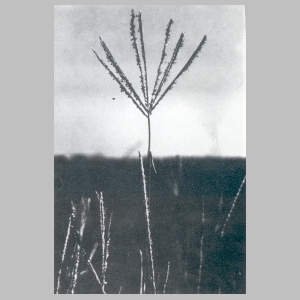
Bermuda grass - Cynodon dactylon
Damp areas in town are host to another common grass, Cynodon dactylon, or Bermuda grass, which spreads by stolons and by underground rhizomes. The flower spikes are in clusters of three to six, radiating like spokes from the tip of the culm. This grass is thin and grows in large patches. It should not be confused with the individual plants or small clumps of Chloris virgata, which have shorter and much thicker spikes that turn rusty brown.
Echinocloa colonum is another less common annual grass that appears sporadically in very moist places, especially where drip irrigation is practised. It has a thicker culm than many local grasses and the flowers are on dense racemes, green or purplish. It is a more solitary grass and tends to be overtaken by S. spicatus and C. dactylon. It is not found in true desert areas because of its high water requirements.
A more striking plant is Polypogon monspeliensis, or annual beard grass, which grows to 80 cms. and is common at the Sewage Farm, though rare elsewhere. It is easily recognisable by the huge panicles which gleam silvery white in the breeze and which have earned it the name 'Rabbit-tail grass' in the USA. It has a short but impressive flowering period usually in May but earlier if there is sufficient rain as this year. Along with C. dactylon it can tolerate salinity levels up to 7000 ppm NaCl, which contributes to their success over other species just above high tide level in marshy conditions.
Among these grasses is one sad story and that is the very recent extermination of Halopyrum mucronatus in its only locality near the old radio mast on the Corniche. The area has been levelled and the once large stand of cereal-like grasses, with stolons extending to fifteen metres, has completely disappeared. As far as is known it has not been recorded elsewhere in the UAE.**
The sedge family, Cyperaceae, is well represented in the Emirates. Both Cyperus conglomeratus and C. rotundus can be found in sandy areas of the town. There is a large and dwarf form of the former present. The larger version constitues one of the major vegetation types in true desert zones of the country. C. rotundus is less common as it requires a higher liquid intake. Another sedge, Scirpus maritimus, is a feature of the Sewage Farm where it appears to be totally dependent on the outfall.
Reeds are not common, but a small stand of Phragmites communis exists just to the right of Muqta Bridge as one leaves the island. One or two very tiny clumps survive precariously inside the town proper. This is by far the tallest grass of the region and can tolerate high salinity levels. Other stands exist where there are permanent pools beside the Al Ain road.
The only rush species on the island is Typhus domingensis, beside one of the outfalls at the Sewage Farm. Camel grazing devastated the site in the winter of 1980 - 1981 but the plants have since recovered. Their status however is dependant on the future plans for the area. The flower head is of typical bullrush appearance. The importance of the Sewage Farm as a relatively undisturbed habitat for natural vegetation cannot be overemphasised in the local context, particularly as the home of rushes and reeds.
This brief account is in no way comprehensive. The species cited have been so identified by the Royal Botanic Gardens at Kew in UK. A complete checklist would include well over a hundred species.
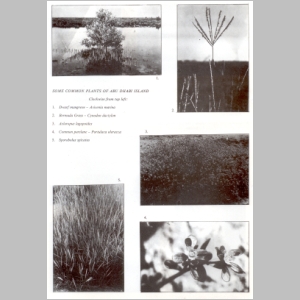
Original page
* parts per million sodium chloride.
Return to text
** Since this article was written, the species has been
recorded on Sadiyat.
Return to text
